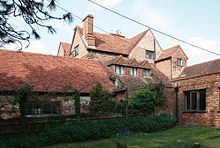 | ||
Similar Wanborough railway station, Waverley Abbey, St Martha's Hill, Audley End House, North Downs | ||
Wanborough Manor is an Elizabethan manor house on the Hog's Back located in Wanborough near Guildford, Surrey. During World War II the manor house was requisitioned by the Special Operations Executive (SOE) to train secret agents and was known as Special Training School 5 (there were six in total across the UK). The manor is a now private residence and is not open to the public.
Contents
History
The manor dates back to the 16th century, but was considerably extended during the 17th century by Thomas Dalmahoy, MP for Guildford. Through his marriage to the widowed Duchess of Hamilton he owned the manor and the Friary Estate in Guildford.
Sir Algernon West, principle private secretary to prime minister William Gladstone, lived in the manor house in the 19th century and was visited by Queen Victoria, who planted a tree in the grounds. Sir Algernon was also responsible for the building of the nearby Wanborough railway station.
The manor has been visited by Otto von Bismarck and Gladstone held cabinet meetings here whilst in his second period of Prime Minister. The Liberal H. H. Asquith leased the manor house until he became prime minister (1908–1916).
Wartime activities
The SOE training establishment STS5 was run by Major Roger de Wesselow, a Coldstream Guards officer. The first intake of SOE trainees occurred in February 1941 and this continued until March 1943 when a new selection procedures were established at Winterfold House, near Cranleigh. Its primary use during the war was to whittle out those not suited to undercover work and begin initial training for those that progressed.
Following initial interviews of potential agents in London, recruits were sent to Wanborough Manor for a three- or four-week period. During this time they were trained in the skills required to work as undercover agents including unarmed combat and the art of silent killing. Successful trainees were also kitted out with the necessary clothes and identity documents. They also received the latest information on what was happening in France and if necessary their French was improved. The Anglo-French author, Noreen Riols -then a teenager -who had been a student at the French Lycee was amongst those sent to Wanborough to provide vital training and vetting. For those that successfully passed the four-week training at Wanborough, further training on using arms and explosives would take place at Arisaig House in Inverness-shire. Agents requiring further intensive training (for example, radio operators went on to further training establishments. Lastly, they would receive parachute training.
Peter Churchill recalls in his book Of Their Own Choice his three-part training at Wanborough which included firearm training, undertaking sabotage with explosives, map reading and communicating via Morse code.
SOE’s ‘F’ Section (French) drew a large number of agents from this establishment – approximately 400 British agents were sent to France of which 130 were trained at Wanborough, and of these 50 failed to return including 12 women.
Evidence of the secret training sessions remain in the grounds of the manor. A bullet-hole ridden wall, as well as holes used for testing explosives.
SOE agents trained at Wanborough Manor
This is an incomplete list:
Wanborough Church plaque
A plaque in Wanborough Church commemorates those agents trained at Wanborough Manor that lost their lives. Diana Rowden, who trained at Wanborough and who operated in France under the codename Paulette was captured and executed in 1943 after four months undercover. There is a memorial to her at Tilford Church.
